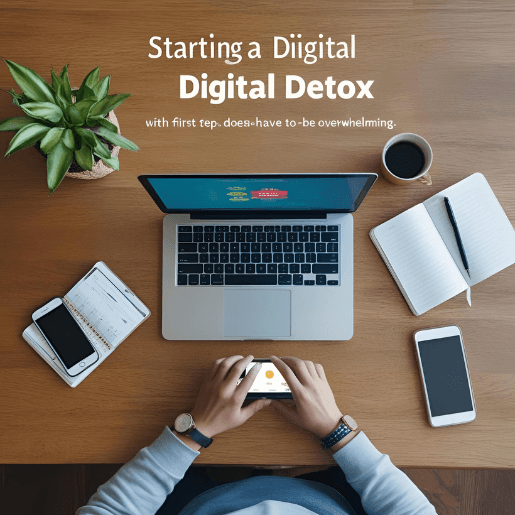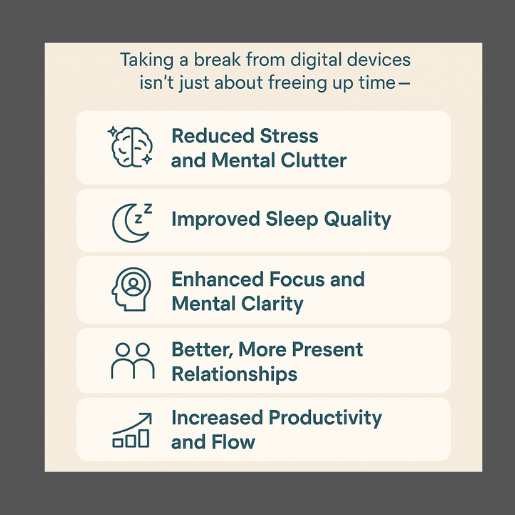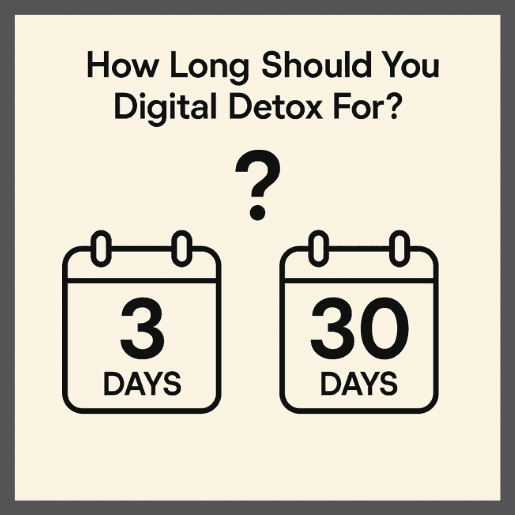In our highly connected world, frequent notifications, emails, and updates from social media can make us feel overwhelmed and mentally exhausted. Amidst this digital chaos, a simple yet powerful practice has emerged: silent walking. This meditative approach to walking offers a respite from the digital noise, allowing individuals to reconnect with themselves and the world around them.
Silent Walking
Silent walking involves walking without digital gadgets such as phones, music, or podcasts. It focuses on staying present, being mindful, and embracing the serenity of silence. This practice fosters mindfulness, reduces stress, and enhances mental clarity
What is a Digital Detox?
During a digital detox, individuals avoid using any digital gadgets like smartphones or computers. The hope is for some soothed-out thinking about actual, physical relationships, and maybe… to be a bit happier. That (disconnecting) is how most people, in particular, can get back in touch with themselves and the world around them.
Why Do We Need the Digital Detox?
In the modern interconnected world, technology influences almost every aspect of our lives, impacting work, communication, entertainment, and even relaxation. Although technology provides undeniable convenience, it also generates a deluge of digital noise that our minds cannot continuously process. This is where the digital detox steps in.
Because Our Brains Weren’t Built for Constant Stimulation
Notifications, messages, emails, news updates, and social media feeds keep your brain in a constant state of alert. Over time, this process leads to mental fatigue, reduced attention span, and difficulty focusing. A digital detox gives your mind the break it desperately needs to rest, reset, and recharge.
To Reduce Anxiety and Overwhelm
Studies show that excessive screen time is directly linked to higher rates of stress, anxiety, and depression. Comparing yourself to filtered realities on social media or being constantly available for work messages can increase emotional exhaustion. A digital detox creates space for calmness, comprehension, emotional control, emotional moderation, and emotional regulation.
To Reconnect With the Present Moment
When was the most recent occasion you had a meal without looking at your phone or went for a walk without listening to a podcast? Detoxing from electronic devices enables you to rediscover mindfulness, reestablish a connection with your surroundings, and be more engaged in your relationships and daily experiences.
To Protect Sleep and Physical Health
Blue light emitted from screens disrupts melatonin production, which can negatively impact the quality of your sleep. Sitting for extended periods in front of digital devices can also lead to poor posture, eye strain, and physical inactivity. Engaging in a detox can help reestablish healthier routines, both physically and mentally.
How Do I Start a Digital Detox?

Starting a digital detox can feel manageable. Taking the initial step is typically the most freeing aspect of the journey. Whether you’re aiming to reclaim your time, sleep better, or simply feel more present, the key is to begin with small, intentional changes. Below are practical, human-centered steps to help you transition into a digital detox smoothly and sustainably.
1. Set Clear Goals
Before anything else, know your “why.” Ask yourself what you want to gain from your detox.
- Do you want to reduce screen time?
- Are you investigating how to enhance your nighttime sleep?
- Do you need more mental clarity and less digital noise?
Your motivation increases, and you’re more likely to continue with it when your goals are clear.
2. Create Device-Free Zones
Your habits are greatly influenced by your surroundings. Designate spaces where devices are simply not allowed.
- Make your bedroom a screen-free sanctuary.
- Keep phones and tablets off the dining table.
- Consider setting up a reading nook or meditation corner where tech is off-limits.
These zones act as digital boundaries that help your brain relax and reset.
3. Schedule Tech-Free Times
Structure is essential for successful habit change. Set aside a certain amount of time each day to intentionally unplug.
- Try not to use phones during meals or the first hour after waking up.
- To promote healthier sleep, unplug at least an hour before going to bed.
- Use calendar reminders to build consistency.
Over time, these moments of disconnection become a natural part of your daily rhythm.
4. Inform Others
Going on a digital detox is easier when people around you understand what you’re doing—and why.
- Make sure to inform your family and close friends about your plan.
- Establish deadlines for text or email responses.
- Encourage others to join you or support you by reducing their screen time, too.
Social accountability often makes the process feel less isolating and more empowering.
5. Replace Digital Time With Meaningful Alternatives
You’re not just removing screens—you’re making space for what matters more.
- To re-establish a connection with nature and your inner thoughts, take quiet walks.
- Start journaling to process your emotions without digital input.
- Read physical books, cook new recipes, paint, or simply rest.
Filling the digital gap with enriching offline activities helps retrain your attention and bring joy back into your routine.
Digital Detox Retreat

For a full digital detox, there are also retreats offering programs that blend tech abstinence with yoga, meditation, and nature walks. These retreats provide a nurturing space to rest, renew, and cultivate mindfulness.
Why Choose a Digital Detox Retreat?
In today’s overstimulated world, a digital detox retreat isn’t just an escape—it’s a full reset for your nervous system. Unlike temporary tech breaks at home, retreats offer complete immersion in tech-free environments, allowing your mind and body to truly unplug. These experiences are especially valuable for those feeling overwhelmed by screen time, constant notifications, or emotional burnout triggered by digital overload.
What a Digital Detox Retreat Looks Like
These retreats go beyond just turning off your phone—they’re about intentionally slowing down and replacing digital noise with restorative routines that promote mental clarity and emotional healing.
Common features include:
- Technology-free zones (no Wi-Fi, no phones, no laptops)
- Guided yoga and meditation sessions
- Mindful meals made from local, whole ingredients
- Nature walks or silent hikes
- Journaling, breathwork, or sound therapy workshops
- Evening group reflections or solo contemplation time
Each element is curated to bring you back into presence—into your body, your senses, and your inner awareness.
How Retreats Help Rebuild Stillness and Awareness
At first, the absence of digital devices can feel disorienting. It’s common to instinctively reach for your phone or feel that odd “phantom vibration” sensation. But within a day or two, your brain begins to decompress from constant stimulation. You begin to notice your thoughts again, tune in to your environment, and tap into your inner dialogue without external noise clouding your focus.
Participants often report:
- Improved sleep and circadian rhythm
- More meaningful conversations
- A deeper sense of calm and focus
- A reset of their digital boundaries
These aren’t temporary benefits—they can reshape your daily relationship with technology when you return home.
A digital detox retreat is more than a short break—it’s a deep recalibration. It shows you what life feels like without digital demands—and teaches you how to bring that peace back with you. You don’t just feel at ease when you depart—you feel reconnected with yourself. The silence, the space, and the presence you rediscover become your tools for better living long after the retreat ends.
Digital Detox Benefits

Taking a break from digital devices isn’t just about freeing up time—it’s about freeing up mental space. We live in a hyper-connected world where our brains rarely get a moment to rest. Every ping, swipe, and scroll stimulates a response, often keeping us in a subtle but chronic state of alertness. A digital detox allows your nervous system to recalibrate, helping you feel grounded and clear-minded again. And while the idea of unplugging might feel intimidating, the rewards are often immediate and surprisingly profound.
Reduced Stress and Mental Clutter
One of the most noticeable benefits of a digital detox is the reduction in stress levels. Studies indicate that frequent device usage is linked to elevated cortisol, the body’s primary stress hormone. Constant notifications, email alerts, and news updates keep the brain in a state of anticipation, disrupting emotional balance. Taking a step back from these triggers allows your mind to find some calm. Instead of reacting to external inputs, you start listening to yourself. After even a short digital break, many people report feeling calmer, more centered, and less anxious.
Try turning your phone on Do Not Disturb mode during meals or after 8 PM to give your nervous system a daily break.
Improved Sleep Quality
Screen time before bed, especially blue light from phones and tablets, suppresses melatonin, the hormone responsible for regulating sleep. Even scrolling through social media for a few minutes can delay your natural sleep-wake cycle and reduce sleep quality. During a digital detox, as screen exposure drops, your body can begin to return to its natural circadian rhythm. People often find they fall asleep faster, sleep more deeply, and wake feeling truly rested, without the mental fog that follows an evening of doomscrolling.
According to the Sleep Foundation, even 30 minutes of screen-free time before bed can significantly improve REM sleep.
Enhanced Focus and Mental Clarity
One of the most powerful transformations people report after a detox is improved attention span. Digital devices—especially social media apps—are designed to hijack focus and reward quick, shallow interactions. When we’re constantly switching between texts, apps, and tabs, our brain never settles into deep work mode. Stepping away from this pattern can feel like hitting a mental refresh button. With fewer distractions, you’re able to focus on tasks longer, think more clearly, and even access deeper levels of creativity and problem-solving.
Want to boost your productivity further? Combine your detox with time-blocking or Pomodoro techniques to create focused work sessions.
Better, More Present Relationships
We’ve all experienced it: you’re in the middle of a conversation, and the other person seems to be only half-listening while they scroll through their phone. It’s become the norm, but it also quietly erodes connection. One of the most valuable benefits of a digital detox is the chance to reconnect with the people around you. Without phones on the table or in hand, conversations go deeper. You notice body language, facial expressions, and emotional cues you might’ve otherwise missed. This kind of undistracted presence strengthens bonds, deepens empathy, and makes interactions more rewarding.
If you’re doing a family detox, try device-free dinners or outdoor walks together to create shared moments of presence.
Increased Productivity and Flow
When you eliminate distractions, a remarkable phenomenon occurs—flow. This is the moment when you forget about everything else and fully immerse yourself in what you’re doing. Whether you’re writing, designing, studying, or cleaning, digital detoxes help you re-enter that state of focused productivity. You accomplish more in a shorter amount of time while maintaining high quality. Plus, your brain starts to associate work with satisfaction, not just stress. It’s no coincidence that many high performers swear by routine tech breaks to protect their time and attention.
✅ Consider starting your day without checking your phone for the first hour. It helps set a calm, intentional tone for the rest of your day.
Along with the primary benefits mentioned earlier, you may also observe:
- Better posture (less screen hunch)
- Reduced eye strain and headaches
- Greater appreciation for nature and surroundings
- More time for hobbies and self-reflection
- Boosted self-esteem from less social comparison
A digital detox isn’t just a break from tech—it’s an invitation to return to yourself. It’s an invitation to feel more, notice more, and live more fully in the present moment.
Digital Detox Challenge
Starting a digital detox challenge can truly change your perspective. For instance, a 7-day digital detox challenge involves gradually reducing screen time, turning off notifications, and designating device-free zones in your home. This structured approach helps individuals ease into the detox process and experience its benefits.
Rethinking Your Relationship With Technology
Embarking on a digital detox challenge is not about proving your willpower—it’s about discovering how deeply intertwined your digital habits are with your mood, your focus, and your sense of control. When you step away from the constant noise of notifications, emails, and endless scrolling, you’re not just unplugging your phone—you’re untangling your nervous system from chronic overstimulation. Even the most well-meaning individuals often fail to recognize the extent to which we resort to our devices due to boredom or habit. That’s what makes a structured digital detox challenge so powerful—it creates intentional boundaries that reveal what truly holds your attention.
A Gentle Introduction: The 7-Day Detox Framework
The 7-day digital detox challenge is a popular approach that allows you to gradually reduce your screen time, rather than abruptly stopping. On day one, you might simply silence non-essential notifications. By day three, you could designate tech-free times, such as the first hour of your morning or all mealtimes.
By the end of the week, you’re not only reducing usage, you’re actively replacing digital consumption with healthier alternatives: reading, walking, journaling, or even just sitting in silence. It becomes less about restriction and more about redirection.
Scalability: Make It Work for You
What makes this challenge so effective is that it’s scalable—you can start small and adjust based on your lifestyle. Some people take it further by removing social media apps entirely for the duration or turning their phone on airplane mode for several hours a day. Others find value in simply tracking their screen time and reflecting on what triggers their usage. The beauty of the challenge is that it meets you where you are. It doesn’t shame you for your digital dependence—it simply invites you to explore a more intentional relationship with your tech.
Unexpected Gifts: The Benefits You Don’t Anticipate
Along the way, most people discover unexpected benefits. You might realize how much more present you are with loved ones or how your sleep improves without the glow of a late-night scroll. You may even find that you’re more creative, more energized, and surprisingly less anxious. What’s happening is your brain is finally getting space to breathe, free from the relentless dopamine spikes of digital stimulation. This clarity, this mental spaciousness, is what makes the detox feel like more than just a challenge—it feels like a reset.
Tracking Progress and Staying Intentional
If you’re thinking about giving it a go, be sure to keep track of your experience. Compose a reflection for today. Pay attention to your habits. What do you turn to when your phone is out of reach? How uneasy is it to be stuck in boredom? This self-awareness is invaluable. The purpose of a digital detox challenge isn’t to vilify technology; it’s about taking back control in a world that continually seeks your focus. By taking these steps, you’ll begin to create a presence that no app can replicate—and that’s where the true success lies.
How Long Should You Digital Detox For?

The perfect duration for a digital detox really depends on what you’re hoping to achieve and how you currently use technology. Many individuals begin by taking short daily breaks, like enjoying 30 minutes without devices in the morning or evening. These little moments provide an opportunity for mindfulness and can alleviate stress while remaining open and inviting.
If you’re feeling more burnt out or distracted, you might benefit from a full weekend or 7-day detox, which allows your mind to properly reset. During this time, you can focus on real-life connections, nature, hobbies, and rest. For those seeking a deeper behavioral shift, a 30-day digital detox, like the one outlined in this Forbes feature, can truly transform your digital habits and improve long-term mental clarity.
The key is to start with what feels realistic and sustainable for you. Increasing your offline time gradually is often more effective than abruptly stopping. And remember, even a few hours away from screens daily can dramatically improve your focus, sleep, and mood.
For more guidance on sustainable detox routines and setting boundaries with your devices, check out our guide on Daily Digital Detox Practices at Mind-Waves.com.
Are Digital Detoxes Effective?
Absolutely—digital detoxes are highly effective when done intentionally. Research and real-life experiences consistently show that stepping away from screens can lead to powerful mental, emotional, and physical benefits. Here’s why:
- Improves Mental Health
Spending less time in front of screens is linked to feeling less anxious and depressed. When we step away from the constant comparisons on social media and the overwhelming digital noise, individuals tend to experience greater emotional stability and a deeper sense of contentment. - Enhances Focus and Attention Span
Regular breaks from screens give your brain a chance to reset, helping you concentrate better. Many people report sharper focus and increased productivity after just a few days away from devices. - Reduces Stress and Cortisol Levels
The never-ending stream of notifications can really keep your stress levels high. Taking a break, even just for a little while, helps your nervous system unwind and find its way back to a peaceful state. - Promotes Mindfulness
Without digital distractions, you become more present in everyday tasks—eating, walking, and talking. This presence leads to greater life satisfaction and awareness of your thoughts and emotions. - Improves Sleep Quality
Reducing blue light exposure and screen time—especially at night—helps your body produce melatonin naturally, leading to deeper, more restful sleep. - Increases Appreciation for Offline Activities
Many people rediscover joy in simple things like reading, nature walks, or conversations, often neglected due to screen addiction.
According to a study by the University of Pennsylvania, limiting social media use to 30 minutes a day significantly reduced depression and loneliness in just three weeks.
What Are the Side Effects of Digital Detox?
While digital detoxes offer powerful mental and emotional benefits, the early stages can bring up a few uncomfortable reactions. These side effects are usually temporary and often signal that your mind is adjusting to a healthier rhythm.
Common Side Effects to Expect
In the early stages of a detox, you might notice:
- Anxiety
Anxiety is the state of feeling tense or uneasy without constant connectivity or notifications. - FOMO (Fear of Missing Out)
You worry that you’re missing important updates, messages, or news. - Boredom
Struggling to fill the time that would usually be spent scrolling or tapping. - Withdrawal Symptoms
Your brain adjusts to a lower stimulation level, causing restlessness, irritability, or even phantom phone vibrations.
A study published in the Journal of Behavioral Addictions found that heavy smartphone users often experience withdrawal-like symptoms during tech breaks (source).
These effects typically fade within a few days as your mind begins to recalibrate. Once past the adjustment period, many people report feeling calmer, clearer, and more grounded.
For support on managing this transition, explore our Digital Detox Challenge Guide at Mind-Waves.com.com—a step-by-step plan to help you reset your relationship with technology.
What Happens When You Detox for 3 Days?
A 3-day digital detox might sound short, but it can have a surprisingly powerful impact on your body and mind. Within just 72 hours of unplugging, you begin to notice clear mental and physical shifts.
Day 1: Discomfort and Awareness
- You may feel anxious, restless, or bored.
- There’s a constant urge to check your phone.
- You become aware of how often you reach for devices out of habit.
Day 2: Reconnection and Mental Clarity
- Anxiety begins to fade as your mind slows down.
- You start enjoying simple things—walking, reading, and silence.
- Sleep quality often improves by the second night.
Day 3: Calm and Focus Return
- Your focus sharpens, and mental fog lifts.
- You feel more present and less reactive.
- Emotional balance improves as dopamine levels stabilize.
According to Harvard Health, even short breaks from screens can improve mood and reduce stress.
What is the duration to detox your body?
The body has a natural way of detoxifying itself, primarily through the liver, kidneys, lungs, and skin. But how long it takes to feel detoxed depends on your lifestyle, diet, and level of toxin exposure.
General Detox Timeline
- 24–72 Hours
Your body begins eliminating toxins; you may feel tired, foggy, or slightly irritable during this phase. - 3–7 Days
Energy starts to return. You might find that your skin looks clearer, your digestion feels better, and your mood is lifted. - 2–4 Weeks
Deeper benefits set in—balanced hormones, improved metabolism, and mental clarity.
Factors That Influence Detox Speed
- Hydration levels
- Sleep quality
- Physical activity
- Diet (whole, unprocessed foods accelerate the process)
For natural detox support, consider lemon water, leafy greens, and fiber-rich foods. According to the Cleveland Clinic, your body is always detoxing, but healthy habits help it function optimally.
Taking a 3-day vacation from digital devices can significantly improve your mood, sleep, and concentration and focus. Physically, the body begins to reset, reducing eye strain and improving posture. While the mental benefits can be felt within days, establishing lasting habits may require longer periods, such as a 30-day detox.
How Do You Know When Detox is Working?
You’ve unplugged, limited screen time, maybe even taken a silent walk or two, but how do you know your digital detox is doing its job? The signs aren’t always dramatic, but they’re real—and they often show up in your daily routines and emotional responses.
Key Signs Your Digital Detox is Making a Difference
- Improved Sleep
You’re drifting off to sleep more quickly and waking up feeling rejuvenated. Without late-night scrolling or blue light interference, your body naturally resets its circadian rhythm. - Enhanced Mood
You feel noticeably lighter, less anxious, and more emotionally stable. Many people experience a lift in mood just a few days into a detox. - Increased Productivity
With fewer distractions, you’re completing tasks faster and with more focus. Deep work feels more achievable, and your to-do list suddenly seems manageable. - Better Relationships
You’re more present in conversations, more attentive with loved ones, and less reactive. Making eye contact takes the place of looking at a screen, allowing for a deeper connection.
Research from Harvard Medical School confirms that limiting screen time can lead to measurable improvements in mental health and interpersonal relationships.
What Are the Three Steps in the Detoxification Process?
Whether you’re detoxing your body or your brain from digital overload, the process usually follows three core phases: recognition, action, and maintenance. These steps are not only essential for success but also help ensure that your detox isn’t just a temporary break—it becomes a lifestyle shift that supports your well-being long term.
1. Recognition: Becoming Aware of the Problem
The first and most crucial step in any detox, especially a digital detox, is simply recognizing that there’s a problem. Are you constantly reaching for your phone even when there’s nothing to check?
Are you experiencing a sense of mental fog, feeling overwhelmed, or finding yourself emotionally exhausted? Recognizing what influences you is key to understanding how your screen habits might impact your sleep, mood, relationships, or productivity. This genuine understanding of oneself paves the way for true transformation. Without it, any detox effort is merely superficial.
2. Action: Taking Steps to Reduce Digital Consumption
Once you’re aware of the issue, it’s time to take action. Taking action doesn’t mean deleting every app overnight or tossing your phone in a drawer—it means setting intentional boundaries. Actions may include turning off notifications, creating tech-free zones at home, or starting with a 7-day digital detox challenge. You might replace screen time with mindful alternatives like silent walking, journaling, or reading. The key is to reduce unnecessary digital input while filling that space with restorative, meaningful habits.
3. Maintenance: Creating Long-Term Balance
Detoxing is a process that requires long-term balance. In this third stage, you focus on sustaining the healthier habits you’ve created. That could mean weekly digital sabbaths, continued device-free mealtimes, or ongoing screen-time tracking. The goal is not perfection, but consistency. When maintenance becomes part of your lifestyle, the benefits of your detox—better sleep, mental clarity, improved mood—become your new normal.
For a full guide on sustaining digital wellness, refer to our Digital Detox Lifestyle Tips.
Silent walking and digital detoxes offer powerful tools to combat the overstimulation of modern life. By intentionally disconnecting from digital devices and embracing the present moment, individuals can experience enhanced mental clarity, reduced stress, and improved overall well-being. Whether it’s a short daily walk without your phone or a month-long digital detox, taking steps to unplug can lead to profound personal growth and a renewed sense of balance.
Disclaimer: Disclaimer: This article is intended solely for informational purposes and is not intended to serve as a substitute for professional medical or psychological advice. If you’re experiencing severe stress, anxiety, or digital dependency, please consult a qualified health professional.
Ready to Reclaim Your Space?
Take the first step toward clarity and calm—start your digital detox journey today. Whether it’s a 10-minute silent walk or a full weekend unplugged, your mind deserves the break.
🌿 Visit Mind-Waves.com for more guides, challenges, and practical tools to help you unplug and reconnect with what truly matters.

